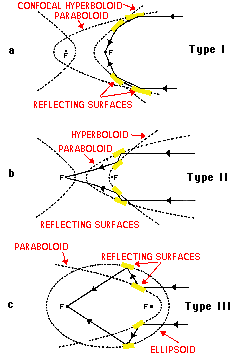Wolter telescope

A Wolter telescope is a telescope for X-rays using only grazing incidence optics. Visible light telescopes are built with either lenses or parabolic mirrors at nearly normal incidence (that is, a nearly perpendicular angle of reflection). Neither works well for X-rays. Lenses for visible light are made of a transparent material with an index of refraction substantially different from one, but there is no equivalent material for x-rays. Conventional mirror telescopes work poorly in the X-rays as well, since the light hits the mirrors at near-normal incidence, where the X-rays are transmitted or absorbed, not reflected.
X-rays mirrors can be built, but only if the angle from the plane of reflection is very low (typically 10 arc-minutes to 2 degrees).[1] These are called glancing (or grazing) incidence mirrors. In 1952, Hans Wolter outlined three ways a telescope could be built using only this kind of mirror.[2][3] These are called Wolter telescopes of type I, II, and III. Each has different advantages and disadvantages.[4]
Wolter's key discovery was that by using two mirrors it is possible to create a telescope with a usably wide field of view. In contrast, a grazing incidence telescope with just one parabolic mirror could focus X-rays, but only very close to the centre of the field of view as it would suffer from extreme coma.
See also
- List of telescope types
- Nuclear Spectroscopic Telescope Array (NuSTAR) (2012+)
- Swift Gamma-Ray Burst Mission Contains a Wolter Type-I X-ray telescope (2004+)
- Chandra X-ray Observatory Orbiting observatory using a Wolter X-ray telescope. (1999+)
- XMM-Newton Orbiting X-ray observatory using a Wolter Type-I X-ray telescope. (1999+)
- ROSAT Orbiting X-ray observatory (1990-1999)
- Neutron microscope
References
- ↑ Kulinder Pal Singh. "Techniques in X-ray Astronomy" (pdf).
- ↑ Wolter, H. (1952). "Glancing Incidence Mirror Systems as Imaging Optics for X-rays". Annalen der Physik. 10: 94. Bibcode:1952AnP...445...94W. doi:10.1002/andp.19524450108.
- ↑ Wolter, H. (1952). "A Generalized Schwarzschild Mirror System For Use at Glancing Incidence for X-ray Imaging". Annalen der Physik. 10: 286. Bibcode:1952AnP...445..286W. doi:10.1002/andp.19524450410.
- ↑ Petre, Rob. "X-ray Imaging Systems". NASA.
- Arndt Last. "Wolter-optics". Retrieved 8 Sep 2016.